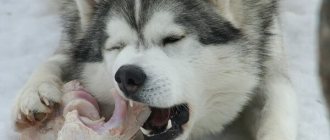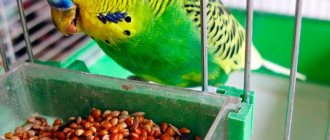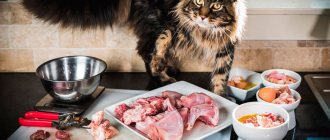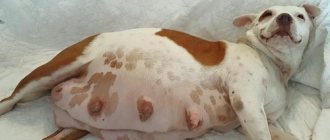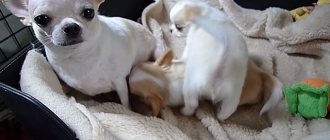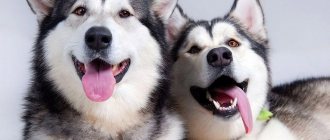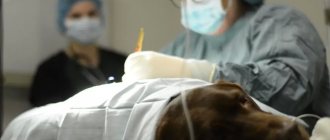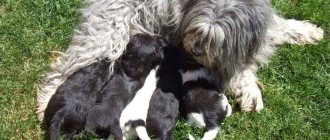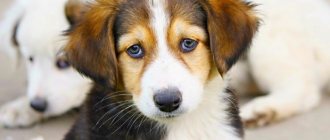If your family has decided to buy a Chihuahua, then the question certainly arises: what do they eat, what can and cannot be fed to the dog at home. The problem is that it is very difficult for a novice owner to make a decision, because he does not know what is better to choose, ready-made food or natural food. There are also hundreds of manufacturers of ready-made food on the market, and you run the risk of buying a low-quality product. In this article you will learn everything about the features of feeding a Chihuahua and learn how to do it correctly.
Unfortunately, when it comes to pet nutrition, people don't pay much attention to it. And all because many people do not know and have no idea about the importance of diet and its impact on the dog’s life. However, you cannot treat the issue of dog nutrition so frivolously!
Why do you need proper nutrition?
Proper nutrition is the key to health and longevity for any Chihuahua. After all, it affects the growth and development of both a puppy and the maintenance of the tone of an adult dog. Normal functioning of the digestive system, the body's resistance to infections, poisons and parasites, strong teeth, good gums, the formation of a strong musculoskeletal system and uninterrupted functioning of the central nervous system, strong muscles and joints - all this is impossible without specialized feeding.
The diet should be balanced. And food must contain all vitamins, minerals, micro and macroelements. Food at home is the main source of energy, this expresses the dog’s need for proteins, fats and carbohydrates.
Did you know the difference between the diet of humans and dogs? It lies in the fact that a person needs to eat fruits and vegetables to obtain vitamin C, and the dog’s body produces it itself.
Squirrels
Proteins are involved in the construction of tissues and cells, regulation and metabolism processes. These high-molecular compounds, built from 20 amino acid residues, play a primary role in the life of all organisms. The most protein is found in meat, fish, eggs, legumes and dairy products.
Carbohydrates
Carbohydrates are complex organic compounds consisting of sugars, starch and cellulose. Foods rich in carbohydrates include flour products, cereals, wheat, rice and vegetables. Fiber not only improves intestinal motility, but also slows down the absorption of sugar, so it can be included in the diet of dogs with diabetes. Excessive consumption can cause inability to absorb vitamins and minerals, flatulence and diarrhea. It is recommended to use corn, wheat and soy with caution; in addition to fiber, they contain allergens.
Fats
There has long been an opinion that fat is the main enemy of a healthy physical form, because its excess is deposited on organs, which leads to impaired metabolism and many diseases, including obesity. And this is true, but only large amounts of fat are harmful. But the body cannot do without an acceptable and obligatory dose of fat! It is a necessary component of proper nutrition. This is the most energy-intensive substance on which thermoregulation, the condition of the coat, as well as the normal functioning of the immune and nervous systems depend.
Vitamins and minerals
There are 2 types of vitamins - water-soluble and fat-soluble. Their deficiency leads to serious diseases, and an excess of one or the other leads to hypervitaminosis and hypovitaminosis - equally dangerous conditions. It is important to maintain a balance of these two types of vitamins. Minerals such as zinc and iron help prevent anemia and other disorders. And calcium and phosphorus are involved in the formation of the skeleton and teeth. It should be remembered that the body needs all the elements. But only in the right proportions. For example, an excess amount of phosphorus in the body is fraught with kidney problems.
Your dog should always have access to clean, fresh water!
What are the harms of eggs for a pet?
Along with the usefulness, it is worth considering the side effects manifested in:
- signs of individual intolerance;
- increased gas formation;
- excess cholesterol;
- risk of infection with infectious bacteria.
The animal body perceives any product differently, food intolerance is expressed by allergic signs and digestive system disorders, symptoms appear immediately. New food is fed to the pet gradually and in doses. A poorly tolerated product is excluded from the diet.
Excessive egg treats lead to bloating, active gas formation, the animal will experience discomfort, especially the resulting gases with an unpleasant odor are inappropriate in a house or apartment.
The testicles contain cholesterol, the excess of which leads to deterioration of blood vessels, the formation of blood clots, loss of appetite, flatulence, vomiting, diarrhea, excessive shedding, and itching. It is better to give other treats to dogs with poor cholesterol levels.
Eating eggs without heat treatment risks infection with the causative agent of salmonellosis, pullorosis and other pathogens. Some dog owners feed their pets raw foods without fear, citing the peculiar structure of the canine esophagus and increased gastric acidity, which contributes to resistance to harmful food microorganisms. You need to be more careful when feeding pregnant bitches and puppies whose immunity is weakened or not developed.
Feeding your pet with ready-made dog food eliminates the need to add eggs, otherwise the animal will develop a disease of the pancreas - pancreatitis.
It is recommended to refrain from giving egg treats to dogs with cancer and infectious diseases.
Newborn puppies
There are cases when, for some reason, a nursing bitch cannot provide her cubs with milk, then the mother’s milk is replaced with cow’s or goat’s. The first feeding of the puppy is carried out from three weeks. If this is ready-made food, then it is served only in soaked form. To do this, take a few granules of dry food, pour boiling water over it, leave for 20-30 minutes, and then give the puppies 1 granule.
A few pieces per day will be enough, gradually increasing the amount every day. In the first months they begin to include natural food. It is required to serve boiled meat and cottage cheese (diluted in milk to a more uniform consistency). Food is liquid and soft; dry food in an unsoaked form is strictly prohibited, because the stomach and intestines are not yet ready to digest solid food. From one month of age - rice, buckwheat, oatmeal with water or milk.
In what form, what kind, can it be added to food?
In addition to chicken and quail eggs, dogs are fed duck, goose, turkey, and ostrich eggs, given in small pieces. For purebred individuals with sensitive digestion, it is better to boil the eggs; raw products may contain pathogenic microorganisms; they should not be given fried.
Take the Attention Test! Find 10 differences! (click right here!)
Find the answer Are you bothered by some problem or question? Enter “Breed” or “Name of the problem” into the form, press Enter and you will find out everything about the issue that interests you.
All parts are used for food - white, yolk, shell (crushed), can be served separately or mixed with main food, except dry food.
As you grow older
Puppies feed on their mother's milk until they are approximately 2 months old. But sometimes up to 4 months. It is recommended to completely wean offspring from mother's milk at 3-4 months. Further feeding of the Chihuahua depends on your choice and the dog’s taste preferences. There are 2 ways of feeding: natural and ready-made food.
There are dogs that can consume both types, and there are individuals for whom one type is suitable: either natural or prepared food. Some people experience diarrhea, diarrhea, and stomach problems from natural food, while others have a similar reaction to ready-made food. Just watch your four-legged friend. See what he likes to eat more. Does the food cause intestinal upsets and digestive problems? If yes, then this is a signal that the chosen feeding method is not suitable for you and needs to be replaced.
Do not mix natural and commercial food!
Still had to give me pasta?
Can a dog eat boiled pasta?
As mentioned above, rarely and in small quantities. And without the sauce, it’s still not a person. The dog will happily eat the sauce, but what benefit will it bring to the dog? Absolutely none.
Before giving pasta to your pet, it must be properly boiled. Do not boil it, but boil it well.
There should not be any slight “dampness”; dogs should not have poorly cooked foods - either raw or well-cooked. In the case of pasta, the raw option, of course, is not suitable.
Natural or dry food, which is better?
There is no clear answer. Each of them has its own pros and cons . Many people beat themselves in the chest, claiming that “natural” is better, since the owner independently monitors what goes into his dog’s body, and these products contain all the necessary substances, minerals and vitamins. However, they are mistaken, because quite often such nutrition is not balanced, and it remains very difficult for a person to choose the right proportions. At a time when everything is already calculated in the package of dry food.
Is it possible to give bread to a dog?
As a rule, a dog will never refuse a piece of bread. Some people love it in its pure form, while others adore the delicacy in the form of a slice soaked in meat sauce or sour cream. However, it is incorrect to say that all products that are beneficial to humans also benefit animals.
The digestive system of dogs, which are natural predators, has a characteristic feature. As long as the diet does not contain carbohydrate food, there are no digestive enzymes in the dog’s saliva.
As soon as the dog begins to eat bread, amylolytic enzymes that break down carbohydrates are activated. They are secreted by the cells of the salivary glands. Bread is a source of carbohydrates, so its amount must be kept under control, this is especially true for sedentary dogs.
Flour products are not the most necessary product in an animal’s diet, especially if they already receive carbohydrates in the form of porridge. You should not give your dog soft, fresh bread, as yeast provokes the fermentation process. This leads to disruption of the intestinal microflora, bloating, and colic. In addition, soft bread (including pancakes, pancakes, etc.), turning into a paste in the stomach of a pet, contributes to the occurrence of pathologies of the digestive tract.
Occasionally, you can pamper your pet with rye, whole grain crackers, and unleavened biscuits. In addition, a stale piece of bread can replace a toothbrush in cases where you need to remove plaque.
Ready food
It is divided into dry (pellets) and wet (canned). Today, stores stock a whole range of products from various manufacturers. This or that brand is advertised on television. To choose high-quality food, do not believe advertising, but purchase only premium and super-premium food. These include Acana, Hills, Pro Plan, Orijen, Royal Canin, Eukanuba. In this case, price is an indicator of quality; the higher, the better the product.
pros
- Balance.
- Convenient travel.
- Easy to use.
- Quick cooking.
- Dosage.
- Convenient storage.
Minuses
Possibility of containing harmful additives: preservatives, dyes, flavorings and flavor enhancers.
Check the expiration date carefully and do not feed your Chihuahua an expired product.
Looking at the label
Study the composition. Avoid feeds where the main ingredient is an animal by-product. If “offal” is indicated, it means bones, skin, legs and beaks were used. Basics like these can be subcategorized and printed at the back of the package (with the hope that inattentive shoppers won't notice).
Of course, preservatives are harmful and have a very bad effect on the health of the Chihuahua. All packaged foods inevitably contain them. The safest of them are tocopherols, which are made on a vitamin basis. Such feeds have a shorter shelf life. Synthetic preservatives - BHA, BNT, ethoxyquin cause tumor formation in the stomach of rats, hamsters and mice. If the consumer needs the manufacturer, the telephone number, name and address of the distributor must be printed on the label. Sometimes they even print the email address and website on the Internet.
Don't feed your Chihuahua cat food!
What do you cook dog grains with?
It is advisable to cook in water, since if you do this using meat broth, the shelf life will sharply decrease and the fat content will increase. You cannot use milk; it will be an additional burden for the animal’s body. Give together with protein and fiber: with meat and vegetables.
The cooked product is stored in the refrigerator for no more than two days and meat products and vegetables are added just before feeding.
Remove the meat from the bones and cut into small pieces. Added raw or cooked. It is best to use beef, turkey and rabbit, chicken (with caution). These types of meat are perfect for dietary nutrition.
Offal occupies a special place in a dog's diet. They must be included in the diet, choosing beef and rabbit. When choosing meat products, you should give preference to those that have veins, sinews and any other connective tissue. But not fat, of course.
Often a mixture of cereals is used, which are mixed immediately after cooking or before serving. But they must be cooked strictly separately.
Natural food
If you decide on this diet, then monitor the quality and freshness of the products you purchase. Cooked porridge or other dishes should be at room temperature; do not give your dog hot food so that it does not get burned.
Advantages
- No harmful additives.
- The owner himself chooses the quality and monitors the freshness of the products.
- Contains all micro and macroelements, vitamins and minerals, amino acids.
Flaws
- Cooking requires a huge amount of time.
- Not balanced.
- Difficulty in storage.
Difference between boiled and raw egg for dogs
Raw and cooked products are beneficial, but it has been studied that the digestibility of uncooked eggs is 40% worse.
If the dog is fed raw food, then the testicles are served in a similar form, making sure that they are suitable for consumption; there should be no unpleasant odor or bloody streaks; it is better to use a product from your own poultry.
Uncooked food may contain germs that cause infectious diseases.
Most dog owners, fearing for the health of their pets, heat-treat their eggs. If your dog doesn’t like boiled food, then you need to choose products carefully and buy products from trusted sellers.
Crude protein promotes high-quality metabolism of fatty acids, but it contains avidin, which leads to a deficiency of biotin in the body, the deficiency of which will have to be compensated for by other foods - liver, carrots. In practice, moderate consumption of products does not lead to significant blocking of B vitamins.
How to protect yourself from obesity?
This issue should be taken very seriously when caring for your animal. Chihuahua is a breed with a tendency to be overweight. To prevent the occurrence of this disease, follow the general rules.
- These dogs love to eat, and some of them cannot control their satiety. Free access to food is unacceptable.
- Feeding is carried out strictly according to the clock. To avoid malnutrition and oversaturation, do not break the schedule and stick to the established regime.
- Do not feed your dog from the communal table.
Older dogs are more likely to suffer from obesity, and this is quite natural, since many physiological changes occur at this time. Older dogs are less active and their metabolic rate is significantly reduced. It is very sad when obesity appears in young dogs due to overeating and mistakes of their owners.
Most owners do not realize that obesity entails a whole list of concomitant diseases: arthritis, tracheal collapse, inflammation of the ligaments and tenosynovitis, diabetes, diseases of the gastrointestinal tract, heart and kidneys, musculoskeletal system, respiratory tract and dislocations of the kneecaps. These diseases pose a great threat to such a small and fragile dog breed.
Is it possible to use pasta in a dog's diet?
Owners always strive to make their pet’s food varied and tasty. But they approach the concept of taste from their own point of view. Therefore, they often offer their pet a plate of pasta seasoned with a delicious sauce.
Of course, the dog will eat the whole plate at once and will be very satisfied. But will such a treat be beneficial?
Photo: netdna-ssl.com
What is pasta made of? Strictly speaking, it's water and flour. Some types have added egg and butter. It seems that all components pose absolutely no danger. Well, except that wheat can cause allergies.
On the other hand, it turns out that boiled pasta does not provide any benefits, since it does not contain any nutrients. And they are needed only to quickly fill the dog’s stomach and deceive hunger.
If your dog ate pasta, what should you expect? It all depends on the individual characteristics of the body. Some animals eat pasta all their lives, even without the addition of meat and vegetables, and do not feel discomfort. Others experience fermentation, gas formation and diarrhea.
Note that those dogs that eat pasta will, in any case, have health problems. Frequently eating high carbohydrate foods will:
- obesity;
- pancreatitis;
- diabetes mellitus
Many dogs love to play with dry foods and eat them in the process. It is better to protect your pet from such games. Dry pasta, as well as dry instant noodles, can stick to the roof of your mouth, teeth, and throat. The dog will experience agony and suffocate. Once in the stomach, dry products will swell and turn into a sticky lump that is difficult to digest.
There is nothing to say about pasta seasoned with spices and rich sauces. This kind of food should not be given to a dog!
If you still decide to feed the animal with this product, then you should choose products made from durum wheat.
Constantly feeding pasta will only cause harm. However, in some cases, it is acceptable to offer them to your pet. It was said above that they contain practically no useful substances. But there is still a minimal share: B9 and B12, tocopherol, B2 and B3.
Tocopherol has a positive effect on the reproductive system, B vitamins are needed by pregnant dogs and for the normal functioning of the gonads.
Each owner himself decides what to feed his pet, taking into account financial and other possibilities. But cereals are not much more expensive, but they provide much more benefits.
Photo: pixabay.com
Reception frequency
This miniature breed has its own peculiarity - the process of growing up in a Chihuahua differs from its “large brothers”. A dog that reaches 8 months is considered an adult, and at this stage its growth stops.
Chart by age
- From 3 weeks to 2 months - 6 times a day
- From 2 to 6 months - 4 times a day.
- From 6 to 12 months - 3 times a day.
- From 1 year and older - 2 times a day.
- Dogs over 7 years old should be fed once a day.
Quantity
For dosage when feeding dry food, see the packaging. Small puppies start feeding with 1 granule. For one-month-old puppies, the measure will be about 1 - 2 teaspoons of dry or natural food. At 2 months, approximately 1 tablespoon is considered normal. As you grow older, the amount of food will increase, gradually reaching 1.5 - 2 tablespoons. The maximum dose for an adult is 1.5 - 2 tablespoons of food.
How to properly feed your dog eggs
Animals are fed according to their age, body weight, and needs. Adults of average parameters are fed 2 chicken eggs or 4 small quail eggs per week, small breeds - half as much.
Goose, duck, and turkey eggs are larger in size than chicken eggs, they are given less often or in reduced quantities - one piece or half a week; a part equal to an egg of another species is separated from an ostrich egg.
As an additional source of calcium, you can use eggshells, clean and crushed; they are sometimes (no more than half a teaspoon) added to the main food. The shell contains many valuable microelements; such a seasoning will serve as an analogue to a vitamin preparation and will improve the condition of not only the teeth and skeleton, but also the body as a whole.
Eggs cannot be fried; they are given raw or boiled, depending on the type of main food.
In any case, the products must be unspoiled, without bloody impurities or rotten smell. It is important not to upset the nutritional balance and not to overfeed your pet.
You should not give eggs to dogs fed dry food, or to dogs with high cholesterol levels, or those with cancer or infectious diseases.
List of useful products
Meat
Beef, turkey, rabbit, veal, and horse meat are excellent as the main source of protein. Served in chopped boiled form, give preference to lean pieces. Experienced breeders strongly recommend excluding chicken. The risk of infection with growth hormones and antibiotics is too high.
By-products
When it is not possible to cook meat, offal is an excellent alternative. For variety, you can pamper your pet with beef innards: heart, stomach, kidneys, liver, lung, tongue, tripe, udder. It is forbidden to feed raw meat and offal to avoid infection with worms and parasites.
Fish
You should avoid river food, and sea food should be prepared no more than 1-2 times a week. Use low-fat varieties (limonella, cod, trout). The benefits of fish are undeniable, because it is a source of omega 3,6,9 fatty acids. Only it contains the required daily dose of most amino acids, such as glutamine, arginine, leucine, lysine, proline, cystine, alanine, glycine, isoleucine, threonine, valine. Fish also contains tryptophan, which has a beneficial effect on healthy sleep quality. The full composition of B vitamins perfectly supports the functioning of the central nervous system, calms, improves memory and concentration, maintains a good mood, prevents the development of depression, and has a positive effect on brain function.
The content of other vitamins and minerals (A, E, D, K,PP, C) and minerals (calcium, magnesium, sodium, potassium, phosphorus, manganese, selenium, iron, copper, zinc) helps stabilize blood cholesterol levels (bad cholesterol is displayed). Helps in improving the condition of the musculoskeletal system, skin, establishing metabolic processes, maintaining visual function of the eyes, healing and strengthening the cardiovascular system, removing heavy metals and toxins, bringing water balance back to normal, increasing the body's protective functions and strengthening the immune system. Its protein is easily digestible and does not burden the gastrointestinal tract.
Clinical studies from Harvard University have shown that consuming this product significantly reduces the risk of premature death from heart attack and stroke. It should be noted that owners of long-haired representatives will rejoice in the beautiful and shiny coat of their pets, acquired through the use of fish in the diet. It is very important to prepare the product correctly - you cannot fry or smoke it; fish is served only boiled or steamed. Carefully remove the fillet from the bones.
Dairy
Low-fat cottage cheese, kefir, milk, unleavened cheeses.
Cereals
Not all types are suitable, but acceptable - oatmeal, millet, rolled oats, egg, buckwheat, rice. Barley and semolina are practically not digestible and can cause intestinal volvulus. Buckwheat porridge remains the best option.
Vegetables
Boiled or with the addition of vegetable oil, carrots, cabbage, beets, pumpkin, zucchini, cucumber, tomato.
Eggs
No more than 1 - 2 times a week. 1 chicken or 2 quail eggs.
Fruits
Chihuahuas are one of the few breeds that love to eat apples, pears, bananas and tangerines.
Berries
Berries are a real storehouse of vitamins. And not only in the summer. Chihuahuas do not tolerate cold well; in winter they often catch colds, including from a lack of vitamins. To pamper your dog all year round and support its immunity, freeze cranberries, raspberries, strawberries, wild strawberries, blueberries, and currants in advance for the winter.
What to feed a Chihuahua puppy
As a rule, a Chihuahua puppy is purchased at the age of 2 months. From now on he is able to eat on his own. Ask the breeder what he was fed, and continue to give him the same foods at home. Add new foods to your diet gradually to avoid causing stomach upset.
You can use dry or wet food of the highest quality for feeding. It is better to choose premium or holistic food for small breeds. If you have a question about what you can and how to properly feed a Chihuahua at home, other than food, then read the recommendations below.
- Meat. Every day, 30% of the total diet should be meat. Since it is now very difficult to find meat from domestic animals that have been fed only natural food, boil it first. Twice a week, meat can be replaced with boiled fish.
- Cereals. Give us boiled rice, buckwheat, millet. Season the porridge with a small amount of vegetable oil.
- Fermented milk products . Give fermented baked milk, kefir, cottage cheese, and natural yogurt in small portions every day. They can be mixed with cereals. Milk is not recommended for consumption by animals; it can cause stomach upset.
- Vegetables. Vegetables can be fed with zucchini, cucumbers, cabbage, and carrots. It is better to give boiled vegetables, you can mix them with meat.
- Fruits . Give it sometimes as a delicacy or as a reward during training. The best will be raw apples, pears, bananas, cut into pieces.
- Eggs. Once a week, give a boiled egg or an omelet.
Important! Let's see why Chihuahuas should not be fed chicken. If you purchase chicken that was raised at home, then you can safely feed it to your pet. But if this is a broiler chicken that is raised in production, then it is fed with various additives that accelerate growth. Such meat will not benefit Chihuahuas due to its low quality.
How to create a diet?
To ensure a complete and balanced diet, follow the percentage ratio: 36% of all food is meat.
- 16% of all food is dairy products.
- 10% of all food is fish.
- 14% of all food is cereals.
- 15% of all food is vegetables.
- 9% of all food is fruit.
Sample daily menu for an adult dog
- Breakfast. 8.00 - 10.00. Boiled meat (or offal) or steamed trout with zucchini.
- Dinner. 15.00 - 16.00. Kefir, cottage cheese or 2 quail eggs.
- Dinner. 19.00 - 20.00. Buckwheat porridge with carrots, half an apple.
Make sure that your four-legged friend's diet alternates protein foods (fish, meat, eggs, cheese) with cereals, vegetables and fruits every day. So, for example, when choosing meat for the morning, you should provide your dog with vegetables, fruits and grains for lunch and dinner. The next day, choose fish with vegetables for breakfast, and for lunch and dinner, give dairy products, fruits, and porridge. Remember, fruits and vegetables, cereals should be included in every day, and meat, fish and dairy products are the basis of nutrition. Cereals are carbohydrates; too frequent consumption can lead to metabolic disorders.
If there's nowhere to go
Anything can happen in life. Today there is money, tomorrow it is gone. What to do if your family suffers such a fate? How to feed the animal? The family's diet has to be cut, let alone the dog. Can dogs have pasta and potatoes? Pasta should not become a daily food. Sometimes, in small quantities, you can give them, but if you are really “pressed”, it is better to buy a bag of cheap oatmeal or barley groats. Add a little butter or vegetable oil to the finished porridge.
As for potatoes, they should not be given to your pet. The vegetable contains too much starch and too few nutrients.
Food for a pregnant bitch
The nutrition of pregnant and nursing mothers should be special. All basic products remain at your disposal, you just need to arrange them in a new way. If the pet eats store-bought food, then meat and egg yolks are added to it. If he eats natural food, then the first month after mating there is no need to change anything. After 4 weeks, the bitch’s need for proteins, vitamins A, D, E, B1, fish oil and folic acid increases. Hence :
- The share of meat is increasing - 60 - 65% of all food.
- From the 5th week of pregnancy, the bitch eats 3-4 times a day.
- Vegetables are preserved in the same quantity.
- A week before giving birth, calcium-rich and protein-containing foods are removed (to avoid eclampsia).
Can puppies and pregnant women eat eggs?
It is possible and necessary, taking into account the feeding rules. The food of pregnant women, whelping bitches and growing puppies should be rich in vitamins and energetically valuable. Both are allowed raw yolk. It is recommended to avoid uncooked protein due to the presence of avidin, which destroys biotin.
Biotin deficiency leads to deterioration of the coat and skin.
For pregnant females and puppies with undeveloped immunity, the raw yolk is separated from the white, or the testicles are boiled whole, soft-boiled, or a steam omelet is prepared.
Nutrition for a nursing bitch
In the first week after giving birth, a pregnant mother is given tea with milk and honey to enhance lactation. Feeding, as before, is carried out 4 - 5 times a day. Dried apricots and prunes are especially useful during this period. After weaning the puppies, the diet is slowly reduced and returned to the usual amount of food.
If the animal becomes ill from what it eats
Dogs are not picky eaters, so they often eat everything. If you overeat pasta, gas formation or intestinal volvulus may occur.
The owner of the animal should immediately contact a veterinarian. When examining the dog, he will prescribe treatment. This may involve gastric lavage with a special probe. In emergency situations, puncture of the abdominal cavity to remove accumulated gas.
Prohibited Products
Please pay special attention that these foods should not be given to Chihuahuas! For them it is poison!
- Carbonated drinks.
- Alcohol.
- Caffeine.
- Hop.
- Pork.
- Sausage.
- Canned food.
- Tubular bones.
- Legumes.
- Plum pits.
- Apricot kernels.
- Peach pits.
- Walnut.
- Nutmeg.
- Macadamia.
- Avocado.
- Raisin.
- Grape.
- Pepper.
- Sugar, any sweets, candies, chocolate.
- Salt, salty.
- Spicy.
- Smoked.
- Roast.
- Pickled.
- Puddings, cakes, baked desserts.
- Mushrooms.
- Condiments, herbs, spices, mustard.
- Onions, onion powder.
- Potato tops.
- Rhubarb leaves.
- Tomato tops.
- Yeast mixture, flour, cookies, buns, bread.
- Pasta.
- Ice cream.
Content
1. What are the benefits of pasta 2. What can feeding pasta lead to 3. What kind of pasta is ok 4. Consequences of feeding 5. Can it be given to puppies 6. Is it harmful for pregnant women
Animals, like people, need food that contains all the necessary nutrients - proteins, carbohydrates and fats, as well as vitamins, minerals and amino acids. Therefore, the desire of owners who have chosen to feed their pets natural food to diversify their diet is understandable. You can’t feed your pets only meat, but can you give your dog pasta, potatoes, and bread? It turns out yes, but is it necessary?
Benefit
Perhaps no one will argue that chicken and quail eggs are a very healthy product. They contain amino acids, vitamins and other substances. One of the main advantages of the product is its easy digestibility. After introducing treats into the diet, dogs' immunity and coat condition improves: peeling goes away and shine appears.
The shell also contains protein and calcium. You can give your dog some egg shell powder. However, you should not get carried away, since excess minerals interfere with the absorption of other microelements.
It is recommended to add quail eggs to the diet of male dogs before mating. The course starts about a week in advance. Every day the dog is given 1 egg, preferably on an empty stomach. This increases blood circulation in the groin area and helps your pet recover faster.
Briefly about the main thing
- Decide on the type of food, feed either dry food (with wet food and canned food of the same brand) or natural food. Don't mix!
- When feeding natural food, it is necessary to calculate the diet so that it is balanced in protein, fat, carbohydrates and fiber.
- Feeding puppies, as well as pregnant and lactating dogs, differs from the diet of an adult Chihuahua in its normal physiological state.
- It is necessary to add vitamin and mineral supplements to the diet, especially if you feed natural food.
- Under no circumstances should you give your pet foods on the prohibited list.
- If the dog is sick or has allergies, it is necessary to approach its diet with extreme caution.
- There is no need to feed your Chihuahua baby food. There will be no harm from one time, but it is unacceptable on an ongoing basis; a dog’s body is very different from a human’s.
